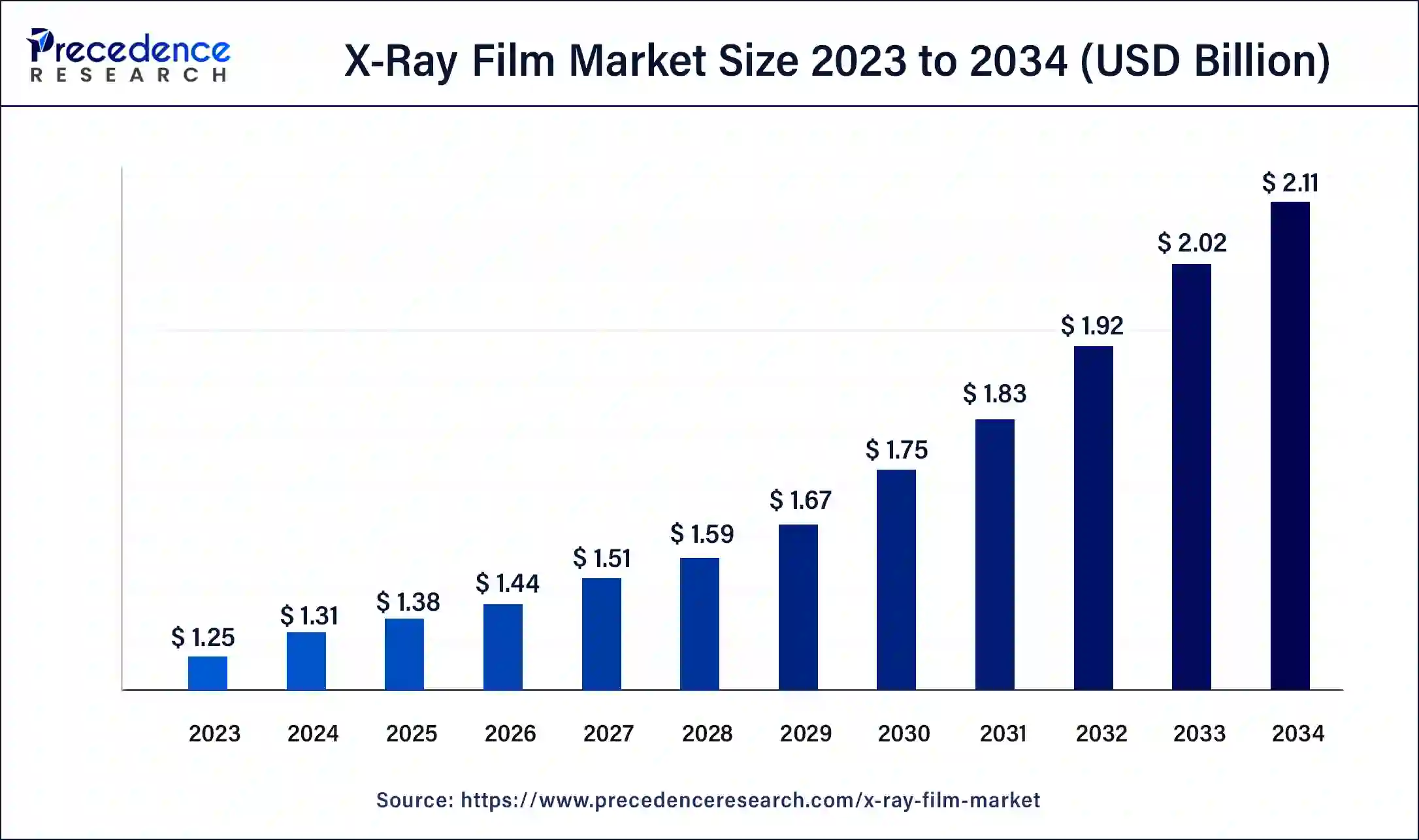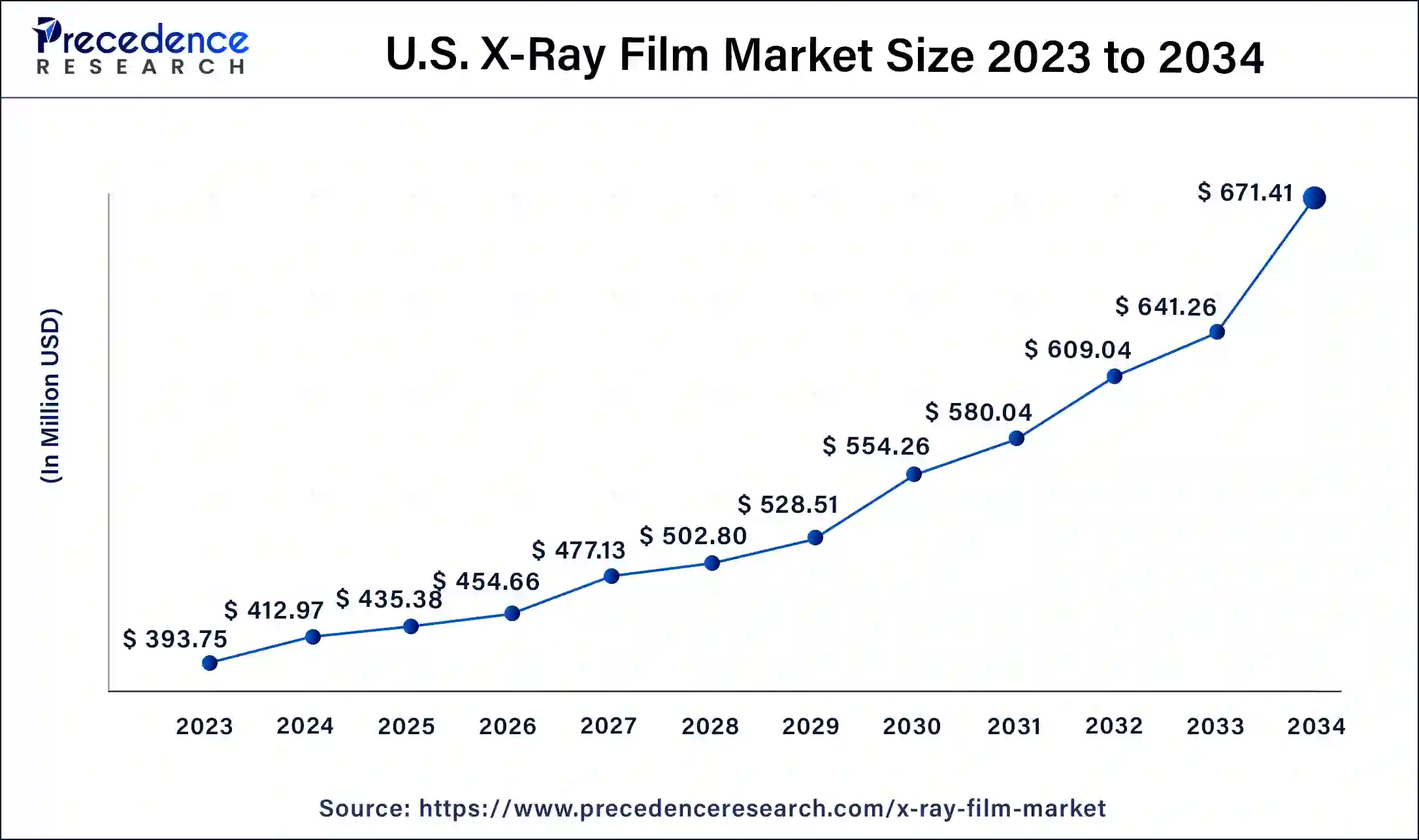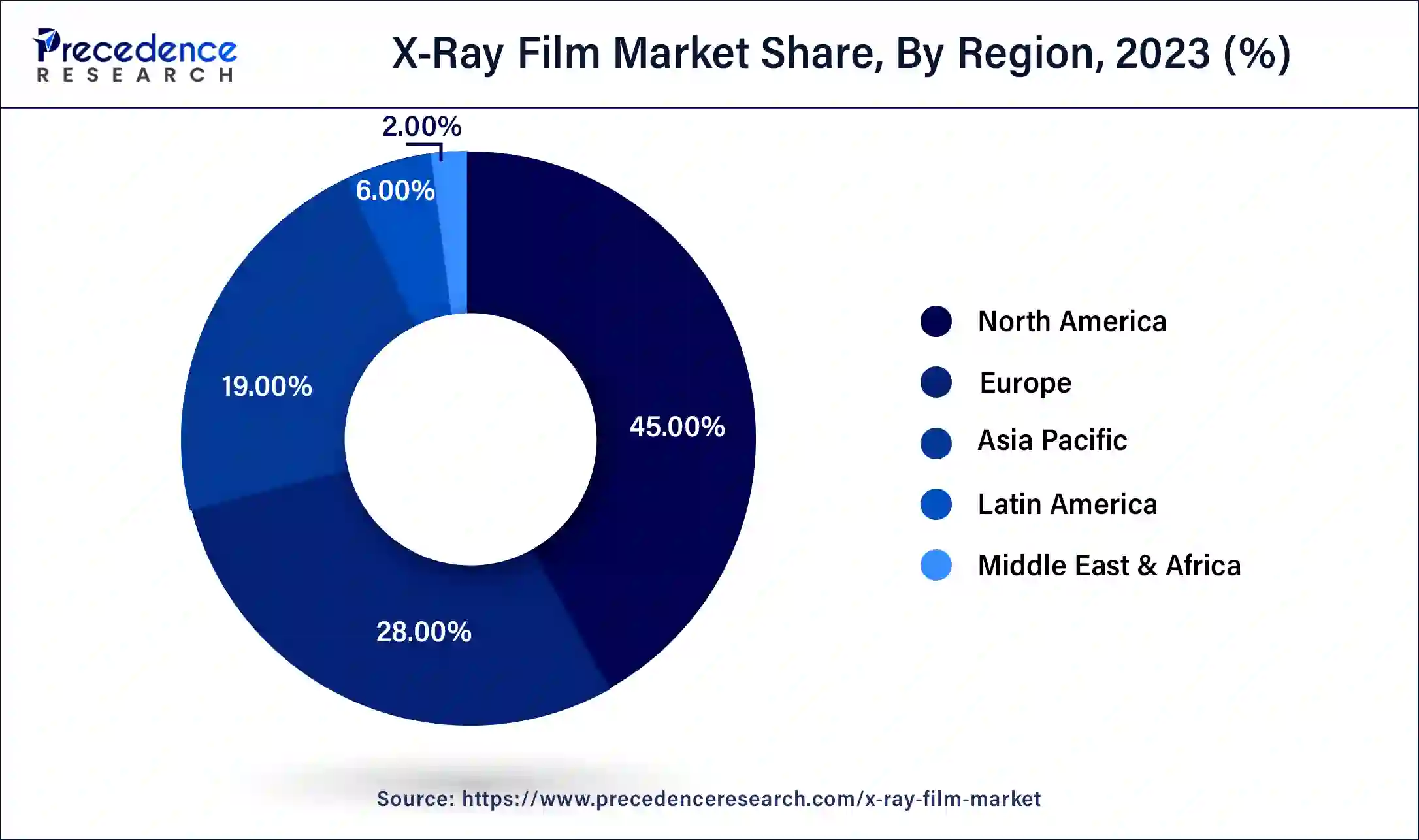List of Contents
What is X-Ray Film Market Size?
The global X-ray film market size accounted for USD 1.38 billion in 2025 and is predicted to reach around USD 2.11 billion by 2034, growing at a CAGR of 4.90% from 2025 to 2034.

Market Highlights
- North America contributed more than 45% of revenue share in 2024.
- Asia-Pacific is estimated to expand the fastest CAGR between 2025 and 2034.
- By type, the full speed blue segment has held the largest market share of 42% in 2024.
- By type, the green segment is anticipated to grow at a remarkable CAGR of 5.2% between 2025 and 2034.
- By end user, the medical segment generated over 49% of revenue share in 2024.
- By end user, the industrial segment is expected to expand at the fastest CAGR over the projected period.
X-Ray Film Market Overview: The Market Snapshot
X-ray film is a crucial component in medical imaging, serving as a traditional yet indispensable tool for capturing internal structures of the human body. Comprising a light-sensitive emulsion on a flexible base, typically made of polyester, these films are exposed to X-rays during medical examinations. When X-rays pass through the body and interact with different tissues, varying levels of radiation absorption occur, creating a latent image on the film. Subsequent chemical processing develops this latent image into a visible representation of the internal structures, enabling healthcare professionals to diagnose and monitor various medical conditions.
Despite advancements in digital imaging technologies, X-ray film remains relevant in certain medical settings due to its cost-effectiveness and reliability. It continues to be employed in radiography, fluoroscopy, and dental imaging, providing a tangible and easily interpretable record of a patient's anatomy. While digital alternatives offer advantages in terms of immediate access and manipulation of images, X-ray film persists as a durable and widely accessible medium in the realm of diagnostic radiology.
X-Ray Film Market Growth Factors
- Technological Advancements: Continuous innovations in X-ray film technology, such as improved emulsions and manufacturing processes, drive market growth by enhancing image quality and diagnostic accuracy.
- Increasing Healthcare Expenditure: Growing investments in healthcare infrastructure globally contribute to the expansion of the X-ray film market as medical facilities upgrade their radiography equipment.
- Rising Aging Population: The demographic shift towards an older population boosts the demand for diagnostic procedures, including X-ray imaging, as elderly individuals often require more medical attention.
- Prevalence of Chronic Diseases: The increasing incidence of chronic illnesses necessitates frequent diagnostic imaging, fostering the demand for X-ray films in the detection and monitoring of these conditions.
- Global Population Growth: A growing global population expands the pool of potential patients, leading to an increased number of medical examinations that utilize X-ray films.
- Emerging Markets: Developing economies witness an uptick in healthcare investments, creating new opportunities for X-ray film market growth in regions with expanding medical infrastructure.
- Advantages in Cost-Efficiency: Despite the rise of digital imaging, X-ray films remain a cost-effective option for many healthcare providers, especially in resource-constrained settings.
- Diagnostic Accuracy: X-ray films continue to be valued for their reliable diagnostic capabilities, making them a preferred choice in certain medical applications.
- Dental Radiography Demand: The dental industry sustains demand for X-ray films, especially in traditional dental radiography, contributing to overall market growth.
- Regulatory Support: Stringent regulatory standards and compliance requirements in the healthcare industry contribute to the stability and reliability of X-ray films, fostering market growth.
- Accessibility in Remote Areas: X-ray films are essential in areas with limited access to digital technologies, ensuring medical imaging services are available in remote and underserved regions.
- Educational and Research Applications: X-ray films play a crucial role in medical education and research, supporting academic institutions and research facilities.
- Increasing Number of Diagnostic Centers: The establishment of diagnostic imaging centers worldwide adds to the demand for X-ray films as a fundamental tool in diagnostic radiology.
- Orthopedic Applications: X-ray films are extensively used in orthopedic imaging for the detection and monitoring of bone-related conditions and injuries.
- Hospital Expansion Projects: The construction and expansion of hospitals contribute to the growth of the X-ray film market, with new facilities incorporating radiography services.
- Government Healthcare Initiatives: Supportive healthcare policies and initiatives by governments globally encourage the adoption of X-ray technology, stimulating market growth.
- Radiation Oncology: X-ray films play a role in radiation therapy planning, further diversifying their applications and driving market expansion in the oncology sector.
- Cultural Acceptance: The familiarity and cultural acceptance of X-ray films among healthcare professionals contribute to their sustained use despite the rise of digital alternatives.
- Emergency Medicine: X-ray films remain essential in emergency medical situations for quick and efficient diagnostic assessments, sustaining market demand.
- Veterinary Applications: The use of X-ray films extends beyond human medicine to veterinary care, contributing to market growth as a critical tool in animal diagnostics.
- Konica Minolta Inc. annual revenue for 2022 was $7.44B and its annual revenue for 2021 was $7.8B.
X-Ray Film Market Outlook: Emerging Trends
- Industry Growth Overview: The growing specific industrial non-destructive testing (NDT) applications are contributing to the industrial growth of the market.
- Sustainability trends: Minimizing environmental impact through enhanced chemical processing particles and reducing the use of hazardous materials in packaging are driving the sustainability trends.
- Major Investors: Diverse leading manufacturers are the major investors in the market.
Market Scope
| Report Coverage | Details |
| Market Size in 2025 | USD 1.38 Billion |
| Market Size in 2026 | USD 1.44 Billion |
| Market Size by 2034 | USD 2.11 Billion |
| Growth Rate from 2025 to 2034 | CAGR of 4.90% |
| Largest Market | North America |
| Base Year | 2024 |
| Forecast Period | 2025 to 2034 |
| Segments Covered | Type, End User, and Region |
| Regions Covered | North America, Europe, Asia-Pacific, Latin America, and Middle East & Africa |
X-Ray Film Market Dynamics
Drivers
Dental imaging demand and diagnostic accuracy
The demand for X-ray films in the medical imaging market is significantly bolstered by the crucial roles they play in dental imaging and ensuring diagnostic accuracy. In dental applications, X-ray films remain a cornerstone in traditional dental radiography, offering detailed imaging of teeth and surrounding structures. Dentists rely on X-ray films to detect dental issues such as cavities, infections, and structural abnormalities, driving consistent demand for these films in dental practices.
Moreover, the inherent diagnostic accuracy of X-ray films solidifies their position in various medical settings. These films provide high-resolution images that allow healthcare professionals to identify subtle abnormalities, aiding in the precise diagnosis of a range of medical conditions. The reliability and clarity of X-ray films make them indispensable in situations where fine details are crucial, contributing to sustained market demand driven by the imperative for accurate and comprehensive diagnostic imaging across diverse medical specialties, including dentistry.
Restraint
Storage and retrieval challenges
The storage and retrieval challenges associated with traditional X-ray films represent a significant restraint on the market's growth. Unlike digital imaging, which allows for electronic storage, X-ray films necessitate physical archiving space. This poses logistical difficulties for healthcare facilities, as maintaining extensive physical film libraries can be space-consuming and organizationally demanding. Retrieving specific patient records from these archives is often time-intensive, potentially impeding the efficiency of medical workflows. In an era where digital solutions offer instant access and seamless retrieval of medical images, the limitations of physical storage become increasingly apparent.
The shift towards electronic health records and Picture Archiving and Communication Systems (PACS) further accentuates the need for streamlined, digital solutions. The storage and retrieval challenges associated with X-ray films hinder the overall adaptability and efficiency of healthcare systems, contributing to a gradual decline in their preference compared to more technologically advanced alternatives.
Opportunity
Digital radiography conversion
The ongoing trend of digital radiography conversion is creating significant opportunities for the X-ray film market. As healthcare providers increasingly transition from traditional radiography to digital imaging systems, there arises a demand for solutions that facilitate a smooth conversion process. Companies in the X-ray film market have an opportunity to provide conversion services, allowing healthcare facilities to upgrade their existing radiography equipment to incorporate digital capabilities. This not only addresses the need for modernization but also caters to institutions that may prefer a phased approach rather than a complete overhaul of their imaging infrastructure.
Moreover, offering digital radiography conversion services aligns with the broader industry shift toward electronic health records and integrated healthcare information systems. The X-ray film market can capitalize on this opportunity by providing comprehensive solutions that bridge the gap between conventional film-based imaging and the benefits of digital radiography, ensuring a seamless transition for healthcare providers.
Segment Insights
Type Insights
In 2023, the full speed blue segment had the highest market share of 42% on the basis of the type. The full-speed blue segment in the X-ray film market refers to a specialized type of X-ray film designed for high-speed imaging applications, particularly in medical diagnostics. This segment caters to the need for rapid image acquisition, allowing healthcare professionals to obtain diagnostic results quickly. The trend in the full-speed blue segment involves continuous advancements in emulsion technology and manufacturing processes to enhance the sensitivity of the film, enabling faster exposure times and improved image quality, thereby meeting the demand for swift and accurate diagnostic imaging in medical settings.
The green segment is anticipated to expand at a significant CAGR of 5.2% during the projected period. In the X-ray film market, the "green" segment refers to environmentally friendly or sustainable X-ray films. Green X-ray films are designed to minimize the environmental impact associated with traditional film processing, often featuring lead-free and recyclable components. A growing trend within this segment involves the development of X-ray films that adhere to eco-friendly practices, addressing concerns about chemical waste and energy consumption. As healthcare industries prioritize sustainability, the demand for green X-ray films is expected to rise, driving innovation towards more environmentally conscious solutions in the diagnostic imaging sector.
End User Insights
According to the end user, the medical segment has held 49% revenue share in 2023. In the X-ray film market, the medical segment encompasses healthcare facilities such as hospitals, diagnostic imaging centers, and clinics that utilize X-ray films for medical diagnostics. A key trend in this segment is the gradual integration of digital radiography alongside traditional X-ray films. While digital technologies continue to advance, medical end-users exhibit a dual-modality approach, leveraging the strengths of both digital and film-based imaging for a comprehensive and flexible diagnostic strategy, catering to the diverse needs of healthcare professionals.
The industrial segment is anticipated to expand fastest over the projected period. In the X-ray film market, the industrial segment refers to end-users within the manufacturing and industrial sectors employing X-ray films for non-destructive testing (NDT) applications. This includes inspecting welds, detecting structural defects, and ensuring product quality in industries such as aerospace, automotive, and manufacturing. A notable trend in the industrial segment involves the increasing adoption of digital radiography systems for NDT, offering enhanced efficiency, immediate results, and streamlined data management. While traditional X-ray films persist in industrial settings, the market is witnessing a gradual shift towards digital solutions for improved precision and workflow integration.
Regional Insights
U.S. X-Ray Film Market Size and Growth 2025 to 2034
The U.S. X-ray film market size is valued at USD 435.38 million in 2025 and is expected to be worth around USD 671.41 million by 2034, at a CAGR of 4.98% from 2025 to 2034.

Large Medical Imaging Infrastructures Facilitate U.S.
The U.S. consists of large medical imaging infrastructures, which are increasing the use of X-ray films for diagnostic purposes. They are also being used in industrial non-destructive testing (NDT). Additionally, the presence of major manufacturers, their development, and innovations is increasing.
Robust Healthcare Infrastructure Drives North America
North America has held the largest revenue share of 45% in 2023. North America commands a significant share in the X-ray film market due to robust healthcare infrastructure, technological advancements, and high healthcare spending. The region's well-established medical facilities, coupled with a matured market for diagnostic imaging, contribute to the dominance. Additionally, a proactive approach to adopting advanced medical technologies, including digital radiography, fuels market growth. The presence of key market players, ongoing research and development initiatives, and a growing aging population further consolidate North America's position as a major contributor to the X-ray film market.

Rapid Technological Advancements Boost the Asia Pacific
Asia-Pacific is estimated to observe the fastest expansion. Asia-Pacific dominates the X-ray film market due to a confluence of factors, including rapid technological advancements, growing healthcare infrastructure, and a substantial patient population. The region's expanding economies, particularly in countries like China and India, drive increased healthcare spending and the adoption of diagnostic imaging technologies. Moreover, a rising prevalence of chronic diseases fuels the demand for X-ray films. Additionally, the industrial sector in Asia-Pacific relies heavily on X-ray films for non-destructive testing, further contributing to the region's major share in the global X-ray film market.
Robust Healthcare Systems Stimulate Japan
The presence of robust healthcare systems in Japan is increasing the demand for X-ray films in Japan. Additionally, the presence of advanced companies is also developing and supplying innovative X-ray films. Moreover, the presence of expertise is driving their innovations, encouraging their use across various sectors.
Growing Industrial Demand Propels Europe
Europe is expected to grow significantly in the X-ray film market during the forecast period, due to growing industrial demand. This, in turn, drives their innovations, where they are utilizing materials that comply with the strict regulations. They are also focusing on the recycling of the films, which are promoting sustainability trends, driving market growth.
Radiography Film Processing Infrastructure Fuels UK
The growing radiography film processing infrastructure in the UK is driving the development of X-ray films. The growing industrial radiography demand is also increasing its use and innovations. The stringent regulations are promoting the use of high-quality and reliable film-based radiography as well.
X-Ray Film Market Value Chain Analysis: Uncovering the Hidden Layers
- R&D
The R&D of X-ray films focuses on the niche application and utilization of advanced digital radiography solutions to offer better efficiency and image quality.
Key players: Fujifilm Holdings Corporation, Carestream Health, Inc. - Clinical Trials and Regulatory Approvals
Demonstration of safety and efficacy equivalence is involved in the clinical trials and regulatory approvals of the X-ray films.
Key players: Fujifilm Holdings Corporation, AGFA-Gevaert Group. - Patient Support and Services
Technical support, maintenance services, and provision of material safety data sheets are provided in the patient support and services of X-ray films.
Key players: Fujifilm Holdings Corporation, Carestream Health, Inc.
Key Players' in X-Ray Film Market and their Offering
- Koninklijke Philips N.V.: X-ray tubes, digital radiography systems, and advanced imaging processing software are provided by the company.
- Fujifilm Holdings Corporation: The company provides Super HR-U, UMMA, and industrial NDT films.
- Canon Inc.: The company develops X-ray tubes, complete digital RF systems, and digital radiography detectors.
- Carestream Health, Inc.: Insight and X-OMAT are provided by the company.
- Hitachi, Ltd.: The company provides X-ray analysis and inspection systems are provided by the company.
X-Ray Film Market Companies
- General Electric Company
- Siemens Healthineers AG
- Toshiba Corporation (now part of Canon Medical Systems Corporation)
- Shimadzu Corporation
- Agfa-Gevaert Group
- Samsung Medison Co., Ltd. (a subsidiary of Samsung Electronics)
- Hologic, Inc.
- Varian Medical Systems, Inc.
- Planmed Oy
- Agilent Technologies, Inc.
Recent Developments
- In April 2023, Shimadzu Corporation, a prominent biotechnology research company, unveiled the EZy-Rad Pro radiography system tailored for clinics. Noteworthy for its user-friendly design, the system aims to enhance operability for healthcare personnel. Shimadzu's focus on simplicity not only facilitates ease of use but also contributes to a more efficient workflow, thereby reducing the burden on patients through shorter examination times.
- In August 2022, GE Healthcare, a leading medical technology company, introduced the Definium 656 HD, its most advanced fixed X-ray system to date. Positioned as a flagship in GE Healthcare's portfolio of fixed X-ray products, the next-generation Definium 656 HD boasts automated features for efficient exams, instilling clinical confidence while streamlining workflow. This innovative system aligns with the company's commitment to enhancing consistency, reducing errors, and ensuring smooth operations in radiology departments.
Segments Covered in the Report
By Type
- Green
- Half Speed Blue
- Full Speed Blue
By End User
- Medical
- Industrial
- Other
By Region
- North America
- Europe
- Asia-Pacific
- Latin America
- Middle East and Africa
For inquiries regarding discounts, bulk purchases, or customization requests, please contact us at sales@precedenceresearch.com
Frequently Asked Questions
Tags
Ask For Sample
No cookie-cutter, only authentic analysis – take the 1st step to become a Precedence Research client



